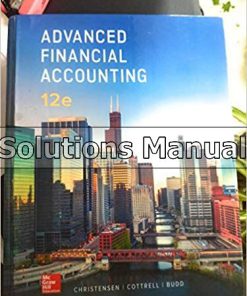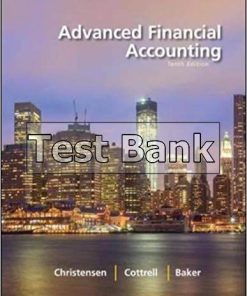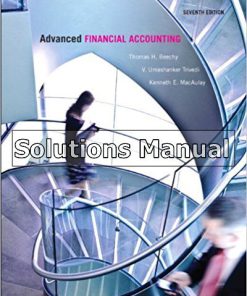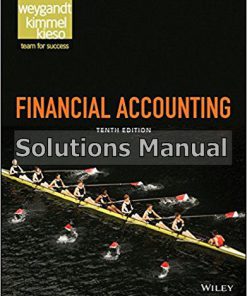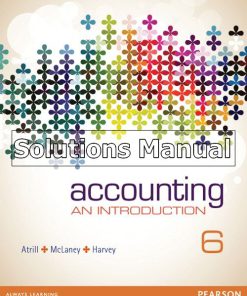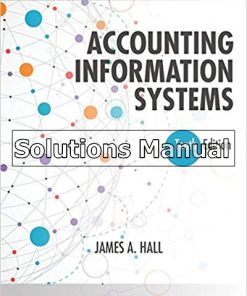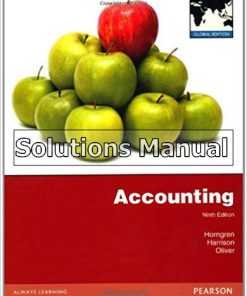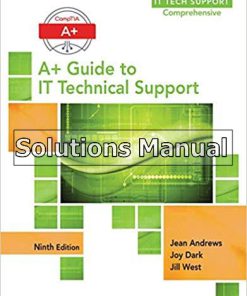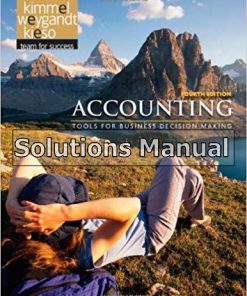Advanced Financial Accounting 10th Edition Christensen Solutions Manual
$26.50$50.00 (-47%)
Advanced Financial Accounting 10th Edition Christensen Solutions Manual.
You may also like
Advanced Financial Accounting 10th Edition Christensen Solutions Manual

Product details:
- ISBN-10 : 0078025621
- ISBN-13 : 978-0078025624
- Author: Ted Christensen
The Tenth Edition of Advanced Financial Accounting is an up-to-date, comprehensive, and highly illustrated presentation of the accounting and reporting principles and procedures used in a variety of business entities. This edition continues to provide strong coverage of advanced accounting topics, with clarity of presentation and integrated coverage based on continuous case examples. The text is highly illustrated with complete presentations of worksheets, schedules, and financial statements so that students can see the development of each topic. Inclusion of all recent FASB and GASB pronouncements and the continuing deliberations of the authoritative bodies provide a current and contemporary text for students preparing for the CPA Examination and current practice. This has become especially important given the recent rapid pace of the authoritative bodies in dealing with major issues having far-reaching The book’s building block approach introduces concepts with simple examples and then gradually introduces complexity, allowing students to easily keep pace with the material.
Table contents:
Chapter 1 Intercorporate Acquisitions and Investments in Other Entities 00 The Development of Complex Business Structures 00 Enterprise Expansion 00 Organizational Structure and Business Objectives Organizational Structure, Acquisitions, and Ethical Considerations Business Expansion and Forms of Organizational Structure Expansion from Within Expansion through Business Combinations Frequency of Business Combinations Complex Organizational Structures Organizational Structure and Financial Reporting Creating Business Entities Business Combinations Forms of Business Combinations Methods of Effecting Business Combinations Valuation of Business Entities Accounting for Business Combinations Acquisition Accounting Fair Value Measurements Applying the Acquisition Method Goodwill Combination Effected through Acquisition of Net Assets Combination Effected through Acquisition of Stock Financial Reporting Subsequent to a Business Combination Disclosure Requirements Additional Considerations in Accounting for Business Combinations Uncertainty in Business Combinations In-Process Research and Development Noncontrolling Equity Held Prior to Combination Acquisitions by Contract Alone Summary of Key Concepts Key Terms Appendix 1A: Methods of Accounting for Business Combinations Questions Cases Exercises Problems Chapter 2 Reporting Intercorporate Interests Accounting for Investments in Common Stock The Cost Method Accounting Procedures under the Cost Method Declaration of Dividends in Excess of Earnings since Acquisition Acquisition at Interim Date Changes in the Number of Shares Held The Equity Method Use of the Equity Method Investor?s Equity in the Investee Recognition of Income Recognition of Dividends Carrying Amount of the Investment Acquisition at Interim Date Difference between Cost of Investment and Underlying Book Value Changes in the Number of Shares Held The Cost and Equity Methods Compared The Fair Value Option Interests Other than Investments in Common Stock Investments in Partnerships Nonequity Interests in Other Entities Additional Considerations Relating to the Equity Method Determination of Significant Influence Unrealized Intercompany Profits Additional Requirements of APB 18 Investor?s Share of Other Comprehensive Income Tax Allocation Procedures Accounting for Investments in Subsidiaries Summary of Key Concepts Key Terms Questions Cases Exercises Problems Chapter 3 The Reporting Entity and Consolidated Financial Statements Usefulness of Consolidated Financial Statements Limitations of Consolidated Financial Statements Subsidiary Financial Statements Consolidated Financial Statements: Concepts and Standards Traditional View of Control Indirect Control Ability to Exercise Control Differences in Fiscal Periods Changing Concept of the Reporting Entity Overview of the Consolidation Process The Consolidation Process Illustrated The Consolidated Entity Mechanics of the Consolidation Process Noncontrolling Interest Computation of Noncontrolling Interest Presentation of Noncontrolling Interest Combined Financial Statements Special-Purpose and Variable Interest Entities Off-Balance-Sheet Financing Qualifying Special-Purpose Entities Variable Interest Entities Additional Considerations?Different Approaches to Consolidation Theories of Consolidation Comparison of Alternative Theories Current Practice Summary of Key Concepts Key Terms Appendix 3A: Consolidation of Variable Interest Entities Questions Cases Exercises Problems Chapter 4 Consolidation of Wholly Owned Subsidiaries Consolidation Procedures Consolidation Workpapers Workpaper Format Nature of Eliminating Entries Consolidated Balance Sheet with Wholly Owned Subsidiary 100 Percent Ownership Carried at Book Value 100 Percent Ownership Acquired at More than Book Value Treatment of a Positive Differential Illustration of Treatment of Debit Differential 100 Percent Ownership Acquired at Less than Fair Value of Net Assets Illustration of Treatment of Differential Consolidation Subsequent to Acquisition Consolidated Net Income Consolidated Retained Earnings Workpaper Format Consolidated Financial Statements?100 Percent Ownership Carried at Book Value Initial Year of Ownership Second and Subsequent Years of Ownership Consolidated Net Income and Retained Earnings Consolidated Financial Statements?100 Percent Ownership Acquired at More than Book Value Initial Year of Ownership Second Year of Ownership Intercompany Receivables and Payables Push-Down Accounting Summary of Key Concepts Key Terms Appendix 4A: Push-Down Accounting Illustrated Questions Cases Exercises Problems Chapter 5 Consolidation of Less-than-Wholly Owned Subsidiaries Effect of a Noncontrolling Interest Consolidated Net Income Consolidated Retained Earnings Differential Noncontrolling Interest Workpaper Format Consolidated Balance Sheet with Majority-Owned Subsidiary Consolidated Financial Statements with Majority-Owned Subsidiary Initial Year of Ownership Second Year of Ownership Discontinuance of Consolidation Treatment of Other Comprehensive Income Modification of the Consolidation Workpaper Adjusting Entry Recorded by Subsidiary Adjusting Entry Recorded by Parent Company Consolidation Workpaper?Second Year following Combination Consolidation Procedures Consolidation Workpaper?Comprehensive Income in Subsequent Years Consolidation of Subsidiaries Acquired Prior to 2009 Differences in Consolidation Procedures Illustration of Consolidation under Previous Accounting Standards Additional Considerations Subsidiary Valuation Accounts at Acquisition Negative Retained Earnings of a Subsidiary at Acquisition Other Stockholders? Equity Accounts Subsidiary?s Disposal of Differential-Related Assets Summary of Key Concepts Key Terms Appendix 5A: Consolidation and the Cost Method Questions Cases Exercises Problems Chapter 6 Intercompany Transfers of Services and Noncurrent Assets Overview of the Consolidated Entity Elimination of Intercompany Transfers Elimination of Unrealized Profits and Losses Intercompany Transfers of Services Intercompany Transfers of Land Overview of the Profit Elimination Process Assignment of Unrealized Profit Elimination Downstream Sale Upstream Sale Eliminating Unrealized Profits after the First Year Subsequent Disposition of Asset Intercompany Transfers of Depreciable Assets Downstream Sale Change in Estimated Life of Asset upon Transfer Upstream Sale Asset Transfers before Year-End Intercompany Transfers of Amortizable Assets Summary of Key Concepts Key Terms Appendix 6A: Intercompany Transfers of Noncurrent Assets?Fully Adjusted Equity Method and Cost Method Questions Cases Exercises Problems Chapter 7 Intercompany Inventory Transactions General Overview Transfers at Cost Transfers at a Profit or Loss Effect of Type of Inventory System Downstream Sale of Inventory Resale in Period of Intercorporate Transfer Resale in Period following Intercorporate Transfer Inventory Held Two or More Periods Upstream Sale of Inventory Basic Equity-Method Entries?20X1 Consolidation Workpaper?20X1 Consolidated Net Income?20X1 Basic Equity-Method Entries?20X2 Consolidated Workpaper?20X2 Consolidated Net Income?20X2 Additional Considerations Sale from One Subsidiary to Another Costs Associated with Transfers Lower of Cost or Market Sales and Purchases before Affiliation Summary of Key Concepts Appendix 7A: Intercompany Inventory Transactions?Fully Adjusted Equity Method and Cost Method Questions Cases Exercises Problems Chapter 8 Intercompany Indebtedness Consolidation Overview Bond Sale Directly to an Affiliate Transfer at Par Value Transfer at a Discount or Premium Bonds of Affiliate Purchased from a Nonaffiliate Purchase at Book Value Purchase at an Amount Less than Book Value Purchase at an Amount Greater than Book Value Summary of Key Concepts Key Terms Appendix 8A: Intercompany Indebtedness?Fully Adjusted Equity Method and Cost Method Questions Cases Exercises Problems Chapter 9 Consolidation Ownership Issues Subsidiary Preferred Stock Outstanding Consolidation with Subsidiary Preferred Stock Outstanding Subsidiary Preferred Stock Held by Parent Subsidiary Preferred Stock with Special Provisions Illustration of Subsidiary Preferred Stock with Special Features Changes in Parent Company Ownership Parent?s Purchase of Additional Shares from Nonaffiliate Parent?s Sale of Subsidiary Shares to Nonaffiliate Subsidiary?s Sale of Additional Shares to Nonaffiliate Subsidiary?s Sale of Additional Shares to Parent Subsidiary?s Purchase of Shares from Nonaffiliate Subsidiary?s Purchase of Shares from Parent Complex Ownership Structures Multilevel Ownership and Control Reciprocal or Mutual Ownership Subsidiary Stock Dividends Illustration of Subsidiary Stock Dividends Impact on Subsequent Periods Summary of Key Concepts Key Terms Questions Cases Exercises Problems Chapter 10 Additional Consolidation Reporting Issues Consolidated Statement of Cash Flows Preparation of a Consolidated Cash Flow Statement Consolidated Cash Flow Statement Illustrated Consolidated Cash Flow Statement?Direct Method Consolidation following an Interim Acquisition Parent Company Entries Consolidation Workpaper Consolidation Income Tax Issues Allocation of Tax Expense When a Consolidated Return Is Filed Tax Effects of Unrealized Intercompany Profit Eliminations Consolidated Earnings per Share Computation of Diluted Consolidated Earnings per Share Computation of Consolidated Earnings per Share Illustrated Summary of Key Concepts Key Terms Questions Cases Exercises Problems Chapter 11 Multinational Accounting: Foreign Currency Transactions and Financial Instruments The Accounting Issues Foreign Currency Exchange Rates The Determination of Exchange Rates Direct versus Indirect Exchange Rates Changes in Exchange Rates Spot Rates versus Current Rates Forward Exchange Rates Foreign Currency Transactions Foreign Currency Import and Export Transactions Managing International Currency Risk with Foreign Currency Forward Exchange Financial Instruments Derivatives Designated as Hedges Forward Exchange Contracts Case 1: Managing an Exposed Foreign Currency Net Asset or Liability Position: Not a Designated Hedging Instrument Case 2: Hedging an Unrecognized Foreign Currency Firm Commitment: A Foreign Currency Fair Value Hedge Case 3: Hedging a Forecasted Foreign Currency Transaction: A Foreign Currency Cash Flow Hedge Case 4: Speculation in Foreign Currency Markets Foreign Exchange Matrix Additional Considerations A Note on Measuring Hedge Effectiveness Interperiod Tax Allocation for Foreign Currency Gains (Losses) Hedges of a Net Investment in a Foreign Entity Summary of Key Concepts Key Terms Appendix 11A: Illustration of Valuing Forward Exchange Contracts with Recognition for the Time Value of Money Appendix 11B: Use of Other Financial Instruments by Multinational Companies Questions Cases Exercises Problems Chapter 12 Multinational Accounting: Issues in Financial Reporting and Translation of Foreign Entity Statements Differences in Accounting Principles Determining the Functional Currency Functional Currency Designation in Highly Inflationary Economies Translation versus Remeasurement of Foreign Financial Statements Translation of Functional Currency Statements into the Reporting Currency of the U.S. Company Financial Statement Presentation of Translation Adjustment Illustration of Translation and Consolidation of a Foreign Subsidiary Noncontrolling Interest of a Foreign Subsidiary Remeasurement of the Books of Record into the Functional Currency Statement Presentation of Remeasurement Gain or Loss Illustration of Remeasurement of a Foreign Subsidiary Summary of Translation versus Remeasurement Foreign Investments and Unconsolidated Subsidiaries Liquidation of a Foreign Investment Hedge of a Net Investment in a Foreign Subsidiary Disclosure Requirements Additional Considerations in Accounting for Foreign Operations and Entities Remeasurement Case: Subsequent Consolidation Workpaper Proof of Remeasurement Exchange Gain Statement of Cash Flows Lower-of-Cost-or-Market Inventory Valuation under Remeasurement Intercompany Transactions Income Taxes Translation When a Third Currency Is the Functional Currency Summary of Key Concepts Key Terms Questions Cases Exercises Problems Chapter 13 Segment and Interim Reporting Reporting for Segments Segment Reporting Accounting Issues International Financial Reporting Standards for Operating Segments Information about Operating Segments Defining Reportable Segments Comprehensive Disclosure Test Reporting Segment Information Enterprisewide Disclosures Information about Products and Services Information about Geographic Areas Information about Major Customers Interim Financial Reporting The Format of the Quarterly Financial Report Accounting Issues Discrete versus Integral View of Interim Reporting Accounting Pronouncements on Interim Reporting International Financial Reporting Standards for Operating Segments Reporting Standards for Interim Income Statements Revenue Cost of Goods Sold and Inventory All Other Costs and Expenses Accounting for Income Taxes in Interim Periods Disposal of a Component of the Entity or Extraordinary, Unusual, Infrequently Occurring, and Contingent Items Accounting Changes in Interim Periods Change in an Accounting Principle (Retrospective Application) Change in an Accounting Estimate (Current and Prospective Application) Change in a Reporting Entity (Retrospective Application) International Financial Reporting Standards for Accounting Changes Summary of Key Concepts Key Terms Questions Cases Exercises Problems Chapter 14 SEC Reporting History of Securities Regulation Electronic Data Gathering, Analysis, and Retrieval (EDGAR) System International Harmonization of Accounting Standards for Public Offerings Securities and Exchange Commission Organizational Structure of the Commission Laws Administered by the SEC The Regulatory Structure Issuing Securities: The Registration Process The Registration Statement SEC Review and Public Offering Accountants? Legal Liability in the Registration Process Periodic Reporting Requirements Accountants? Legal Liability in Periodic Reporting Foreign Corrupt Practices Act of 1977 Sarbanes-Oxley Act of 2002 Title I: Public Company Accounting Oversight Board Title II: Auditor Independence Title III: Corporate Responsibility Title IV: Enhanced Financial Disclosures Title V: Analyst Conflicts of Interest Title VI: Commission Resources and Authority Title VII: Studies and Reports Title VIII: Corporate and Criminal Fraud Accountability Title IX: White-Collar Crime Penalty Enhancements Title X: Sense of Congress Regarding Corporate Tax Returns Title XI: Corporate Fraud and Accountability Disclosure Requirements Management Discussion and Analysis Pro Forma Disclosures Summary of Key Concepts Key Terms Questions Cases Exercises Chapter 15 Partnerships: Formation, Operation, and Changes in Membership Nature of Partnership Entity Legal Regulation of Partnerships Definition of a Partnership Formation of a Partnership Other Major Characteristics of Partnerships Accounting and Financial Reporting Requirements for Partnerships International Financial Reporting Standards for Small and Medium-Sized Entities Accounting for the Formation of a Partnership Illustration of Accounting for Partnership Formation Accounting for Operations of a Partnership Partners? Accounts Allocating Profit or Loss to Partners Illustrations of Profit Allocation Multiple Bases of Profit Allocation Special Profit Allocation Methods Partnership Financial Statements Changes in Membership General Concepts to Account for a Change in Membership in the Partnership New Partner Purchases an Interest New Partner Invests in Partnership Determining a New Partner?s Investment Cost Dissociation of a Partner from the Partnership Summary of Key Concepts Key Terms Appendix 15A: Tax Aspects of a Partnership Appendix 15B: Joint Ventures Questions Cases Exercises Problems Chapter 16 Partnerships: Liquidation Overview of Partnership Liquidations Dissociation, Dissolution, Winding Up, and Liquidation of a Partnership Lump-Sum Liquidations Realization of Assets Expenses of Liquidation Illustration of Lump-Sum Liquidation Installment Liquidations Illustration of Installment Liquidation Cash Distribution Plan Additional Considerations Incorporation of a Partnership Summary of Key Concepts Key Terms Appendix 16A: Partners? Personal Financial Statements Questions Cases Exercises Problems Chapter 17 Governmental Entities: Introduction and General Fund Accounting History of Governmental Accounting Major Concepts of Governmental Accounting Elements of Financial Statements Expendability of Resources versus Capital Maintenance Objectives Definitions and Types of Funds Financial Reporting of Governmental Entities Fund-Based Financial Statements: Government Funds Measurement Focus and Basis of Accounting (MFBA) Basis of Accounting?Governmental Funds Basis of Accounting?Proprietary Funds Basis of Accounting?Fiduciary Funds Budgetary Aspects of Governmental Operations Recording the Operating Budget Accounting for Expenditures The Expenditure Process Classification of Expenditure Transactions and Accounts Outstanding Encumbrances at the End of the Fiscal Period Expenditures for Inventory Accounting for Fixed Assets Long-Term Debt and Capital Leases Investments Interfund Activities (1) Interfund Loans (2) Interfund Services Provided and Used (3) Interfund Transfers (4) Interfund Reimbursements Overview of Accounting and Financial Reporting for the General Fund Comprehensive Illustration of Accounting for the General Fund Adoption of the Budget Property Tax Levy and Collection Other Revenue Expenditures Acquisition of Capital Asset Interfund Activities Adjusting Entries Closing Entries General Fund Financial Statement Information Summary of Key Concepts Key Terms Questions Cases Exercises Problems Chapter 18 Governmental Entities: Special Funds and Government-wide Financial Statements Governmental Funds Worksheets Special Revenue Funds Capital Projects Funds Illustration of Transactions Financial Statement Information for the Capital Projects Fund Debt Service Funds Illustration of Transactions Financial Statement Information for the Debt Service Fund Permanent Funds Illustration of Transactions Governmental Funds Financial Statements Enterprise Funds Illustration of Transactions Financial Statements for Proprietary Funds Internal Service Funds Illustration of Transactions Financial Statements for Internal Service Funds Trust Funds Illustration of a Private-Purpose Trust Fund Agency Funds Illustration of Transactions in an Agency Fund The Government Reporting Model Four Major Issues Government Financial Reports Government-wide Financial Statements Reconciliation Schedules Budgetary Comparison Schedule Management?s Discussion and Analysis Notes to the Government-wide Financial Statements Other Financial Report Items Interim Reporting Auditing Government Entities Additional Considerations Special-Purpose Government Entities Financial Reporting for Pensions and OPEB Plans Summary of Key Concepts Key Terms Appendix 18A: Other Governmental Entities?Public School Systems and the Federal Government Questions Cases Exercises Problems Chapter 19 Not-for-Profit Entities Financial Reporting for Private, Not-for-Profit Entities Important FASB Standards for Not-for-Profit Entities Colleges and Universities Special Conventions of Revenue and Expenditure Recognition Board-Designated Funds Public Colleges and Universities Private Colleges and Universities Health Care Providers Hospital Accounting Financial Statements for a Not-for-Profit Hospital Comprehensive Illustration of Hospital Accounting and Financial Reporting Temporarily Restricted Funds Summary of Hospital Accounting and Financial Reporting Voluntary Health and Welfare Organizations Accounting for a VHWO Financial Statements for a VHWO Summary of Accounting and Financial Reporting for VHWOs Other Not-for-Profit Entities Accounting for ONPOs Financial Statements of ONPOs Summary of Accounting and Financial Reporting for ONPOs Summary of Key Concepts Key Terms Questions Cases Exercises Problems Chapter 20 Corporations in Financial Difficulty Courses of Action Nonjudicial Actions Judicial Actions Chapter 11 Reorganizations Fresh Start Accounting Plan of Reorganization Illustration of a Reorganization Chapter 7 Liquidations Classes of Creditors Secured Creditors Creditors with Priority General Unsecured Creditors Statement of Affairs Additional Considerations Trustee Accounting and Reporting Summary of Key Concepts Key Terms Questions Cases Exercises Problems Index
People also search:
solution manual advanced financial accounting 10th edition
advanced financial accounting 10th edition chapter 2 solutions
advanced financial accounting 10th edition solutions manual pdf
advanced financial accounting 10th edition
advanced financial accounting 10th edition chapter 3 solutions

